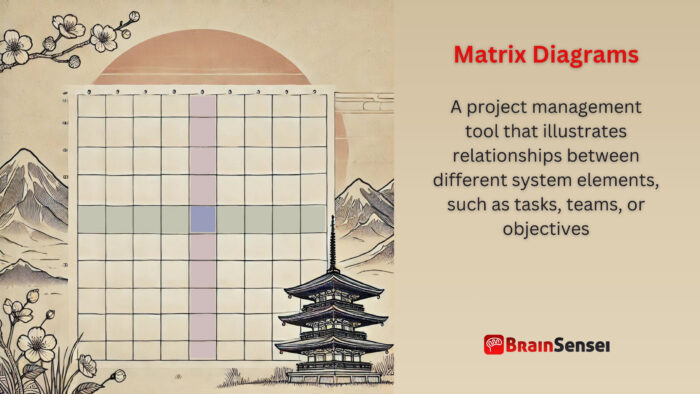
Matrix Diagrams
What is a Matrix Diagram?
A matrix diagram is a project management tool that illustrates relationships between system elements, such as tasks, teams, or objectives. It helps project managers identify dependencies, correlations, and priorities within a project. Matrix diagrams use a grid or table format to compare variables and analyze their interactions, making them essential for decision-making and strategic planning.
Key Takeaways
- A matrix diagram visually represents relationships between multiple factors in a project.
- It is helpful for prioritization, decision-making, and resource allocation.
- Different matrix diagrams exist, including L-shaped, T-shaped, Y-shaped, and X-shaped structures.
- It enhances clarity in complex projects by showing dependencies and connections.
- Commonly used in Six Sigma, Lean methodologies, and project risk assessment.
Understanding Matrix Diagrams
How It Works
Matrix diagrams organize information into a structured format, allowing teams to analyze relationships between elements. They are instrumental for:
- Identifying dependencies in project tasks.
- Evaluating stakeholder influence and engagement.
- Assessing risk impact versus probability.
- Comparing different solutions based on weighted criteria.
Types of Matrix Diagrams
- L-shaped Matrix: Compares two sets of data.
- T-shaped Matrix: Displays relationships among three variables.
- Y-shaped Matrix: Circularly connects three sets of data.
- X-shaped Matrix: Links four elements together.
- C-shaped Matrix: Shows complex interrelationships among five factors.
Notes
- Matrix diagrams simplify complex decision-making by providing structured visualization.
- They are most effective when variables are well-defined.
- Using too many variables can make the diagram difficult to interpret.
- Regular updates are necessary to reflect project changes.
Related Terms
- Responsibility Assignment Matrix (RACI Chart): Defines roles and responsibilities within a project.
- Dependency Mapping: Identifies and visualizes task dependencies.
- Risk Matrix: Evaluates risks based on likelihood and impact.
- Decision Matrix: Compares multiple options against a set of criteria.
- Stakeholder Analysis Matrix: Assesses stakeholder influence and interest in a project.
Examples of Matrix Diagrams in Industry
Manufacturing Industry – Quality Control
In a manufacturing plant, an L-shaped matrix diagram compares the causes of defects with product components. By analyzing the relationships, the quality control team identifies that most defects stem from a particular supplier. The matrix diagram shows that faulty materials supplied by one vendor cause 60% of defects. Investigation into root causes, like material inconsistencies and process failures at the supplier’s facility, becomes the next step for the team. Corrective actions are taken, including holding the supplier accountable, implementing stricter quality checks, and revising the procurement process to ensure higher-quality materials. As a result, the defect rate drops by 30%, and customer complaints decrease significantly. Additionally, the company implements a preventive maintenance program to ensure that machines producing the components operate optimally, further reducing potential defects.
The quality control team continuously updates the matrix diagram to reflect ongoing changes in suppliers and materials. This practice helps them maintain quality standards and address emerging issues promptly. Regular review meetings with suppliers and production teams ensure alignment on quality expectations and corrective measures, fostering a culture of continuous improvement. The matrix diagram also serves as a communication tool, visually illustrating the impact of quality issues on different product lines, which helps the management team make data-driven decisions regarding resource allocation and process improvements.
Healthcare – Patient Risk Assessment
A large hospital uses a risk matrix to assess patient conditions and potential complications. The matrix evaluates patients based on their medical history, current condition, and possible risk factors, such as allergies, medications, and underlying health issues. It helps healthcare providers prioritize care for patients with the highest risks, such as those with life-threatening conditions or a history of severe allergic reactions. By visualizing patient risk levels, hospital staff can allocate resources more effectively, ensuring that critical care teams are available for high-risk patients.
For example, medical professionals categorize a patient with a known history of heart disease who presents with chest pain as a high-risk case. The risk matrix alerts the emergency team to prioritize this patient for immediate evaluation and treatment. The matrix diagram also helps the hospital identify trends in patient risk factors, such as increased respiratory issues during flu season. This information allows the hospital to adjust staffing levels, stock up on necessary medications, and implement targeted patient care protocols to manage seasonal health trends.
To ensure the risk matrix remains effective, the hospital conducts regular staff training sessions on using the tool and updating it with accurate, real-time patient data. The risk matrix is integrated into the hospital’s electronic medical records system, enabling seamless updates and accessibility for all healthcare providers. This approach leads to improved patient outcomes, reduced emergency response times, and more efficient resource allocation across departments.
IT and Software – Feature Prioritization
A software development team uses a decision matrix to evaluate potential features based on user demand, development effort, and business value. The team lists potential features on one axis of the matrix and evaluation criteria, such as impact on user experience, ease of implementation, revenue potential, and technical feasibility, on the other axis. Each feature is scored based on its alignment with these criteria, and the matrix helps the team prioritize features that offer the most significant overall benefit.
For instance, a highly requested feature that improves user onboarding but requires minimal development effort scores higher than a complex feature with low user interest. Using the decision matrix, the team identifies that the top three features for the next software release should focus on improving user navigation, enhancing security, and integrating a popular third-party tool. The team also identifies low-priority features and defers them to future releases, thus allocating limited resources to high-impact projects.
The decision matrix is updated after each sprint planning session to reflect changes in user feedback and market trends. This ongoing evaluation process helps the development team focus on delivering value to users while minimizing resource waste. The matrix diagram also serves as a communication tool, helping stakeholders understand the rationale behind feature prioritization decisions and fostering alignment between the development team and business objectives.
To further enhance the matrix diagram’s effectiveness, the team incorporates a weighted scoring system to account for factors such as customer feedback, revenue impact, and alignment with strategic goals. This approach ensures that they consistently prioritize features with the most significant potential impact, leading to faster time to market for key enhancements and improved user satisfaction.
In addition, the team uses the matrix diagram for regular retrospectives, identifying areas for improvement in their prioritization process and decision-making approach. This continuous improvement mindset ensures that the decision matrix remains valuable for driving product success and achieving long-term business objectives.
By using matrix diagrams across different industries, teams can gain valuable insights into relationships, dependencies, and priorities. This approach can lead to more informed decision-making, optimized resource allocation, and better project outcomes.
Use Cases of Matrix Diagrams
United States (Project Risk Management in Construction)
A construction company in New York uses a risk matrix to evaluate potential project delays due to weather conditions, supply chain disruptions, and labour shortages. By assigning risk scores, they proactively create contingency plans, ensuring timely project completion. The matrix enables project managers to allocate resources efficiently, avoiding bottlenecks and reducing project risks. Additionally, it helps communicate risk assessment findings to stakeholders, improving decision-making and transparency within the organization.
United Kingdom (Logistics and Supply Chain Optimization)
A UK-based logistics firm uses a dependency matrix to assess how delays in one shipment impact downstream deliveries. Using this approach helps the company optimize routes and avoid bottlenecks. The company integrates the matrix into its supply chain management software, allowing real-time updates and adjustments based on changing conditions. By continuously refining the matrix, it enhances operational efficiency and customer satisfaction.
Japan (Manufacturing and Supplier Evaluation)
A Japanese automotive company uses a supplier quality matrix to compare supplier performance, delivery time, and defect rates. This data-driven approach improves vendor selection and production efficiency. The company can proactively address supplier issues before they impact production, ensuring a more reliable and efficient supply chain.
By leveraging matrix diagrams in different business scenarios, organizations can streamline processes, mitigate risks, and enhance decision-making capabilities, leading to increased productivity and improved outcomes.
Best Practices for Using Matrix Diagrams
Matrix diagrams are powerful tools, but their effectiveness depends on proper implementation. Organizations should follow best practices to maximize their benefits.
Define Clear Objectives
Before creating a matrix diagram, identify the problem or decision it will address. Well-defined objectives ensure that the diagram remains focused and valuable.
Select the Right Matrix Type
Different types of matrix diagrams serve various purposes. Choosing the appropriate format—L-shaped, T-shaped, Y-shaped, X-shaped, or C-shaped—ensures the analysis aligns with business needs.
Establish Criteria and Weighting
For decision matrices, defining evaluation criteria and assigning weights helps prioritize effectively. Weighting factors based on importance leads to more informed decision-making.
Keep the Matrix Simple and Readable
Avoid excessive complexity that can make the diagram difficult to interpret. Focus on key relationships and use clear visual indicators to highlight strengths and weaknesses.
Use Accurate and Up-to-Date Data
Matrix diagrams are only as practical as the data they populate. Therefore, they should be regularly updated to reflect current project conditions, risk factors, or decision-making priorities.
Involve Key Stakeholders
Collaboration is crucial when making decisions using matrix diagrams. The team should engage relevant stakeholders to ensure they consider diverse perspectives and insights.
Integrate with Other Project Management Tools
Matrix diagrams should complement other project management methodologies. Risk assessments, performance tracking, and strategic planning tools enhance their utility.
Review and Revise Regularly
Business needs and market conditions evolve. Periodic reviews help ensure matrix diagrams remain aligned with changing priorities.
By following these best practices, organizations can leverage matrix diagrams to improve decision-making, optimize resource allocation, and enhance project outcomes.
Matrix Diagrams: Common Mistakes and Issues
Matrix diagrams are powerful tools, but improper use can lead to inefficiencies, misinterpretation, and flawed decision-making. Below are some common mistakes and challenges organizations face when implementing matrix diagrams.
Overcomplicating the Matrix
One of the most common mistakes is making the matrix diagram too complex. Including excessive variables, criteria, and relationships can make the matrix challenging to read and interpret. Overcomplication can lead to confusion and make decision-making less effective.
Using Outdated or Inaccurate Data
A matrix diagram is only as exemplary as the data that informs it. The analysis and conclusions will be flawed if the data used to populate the diagram is outdated or inaccurate. To maintain reliability, data sources must be regularly updated and validated.
Failing to Define Clear Objectives
If the purpose of the matrix diagram is not well-defined, it can result in ambiguity and misinterpretation. Before creating a matrix, it is crucial to establish clear objectives and ensure all stakeholders understand the diagram’s purpose.
Ignoring Stakeholder Input
A matrix diagram should be a collaborative tool incorporating key stakeholders’ insights. Failure to involve relevant parties can lead to biased analysis and overlooked factors that may be critical to decision-making.
Misinterpreting Relationships
Sometimes, people misinterpret the connections in a matrix diagram, leading to incorrect assumptions about dependencies and priorities. Proper training and a structured review process can help mitigate this risk.
Not Integrating with Other Project Management Tools
Matrix diagrams are most effective when used with other project management methodologies. However, their effectiveness diminishes if teams do not integrate them with broader planning and risk management tools.
Lack of Regular Review and Adjustment
Market conditions, project priorities, and stakeholder expectations change over time. A matrix diagram that is not periodically reviewed and adjusted can become obsolete and mislead decision-makers.
Addressing these common mistakes can optimize organizations’ use of matrix diagrams, leading to improved strategic planning, enhanced collaboration, and better decision-making.
Matrix Diagrams: Frequently Asked Questions (FAQs)
How do you create a matrix diagram?
First, define the variables you want to compare to create a matrix diagram. Then, choose the appropriate matrix type and plot relationships in a grid format. Finally, numerical values or symbols are assigned to indicate the strength of each relationship.
What is the best matrix diagram for decision-making?
A decision matrix is the best tool for evaluating multiple options against criteria, helping teams make data-driven choices.
Can matrix diagrams be used in Agile project management?
Agile teams use matrix diagrams to enhance sprint planning by prioritizing the backlog, analyzing stakeholders, and mapping dependencies.
What software do people use to create matrix diagrams?
Standard tools for creating matrix diagrams include Microsoft Excel, Lucidchart, Miro, SmartDraw, and Visio.
How do matrix diagrams help in risk management?
A risk matrix helps teams assess probability vs. impact, allowing them to address high-risk factors in a project proactively.
Additional Resources
Preparing for a PMI certification?
- Exam Prep Courses: PMP®, CAPM®, and PMI-ACP®
- Exam Simulators: PMP®, CAPM®, PMI-ACP®, PMI-PBA®, PMI-RMP®, PMI-SP®, PgMP®, and PfMP®
- Professional Development Units (PDUs): 15, 30, and 60 PDU Bundles



